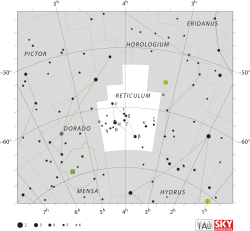Iota Reticuli
| Observation data Epoch J2000.0 Equinox J2000.0 (ICRS) | |
|---|---|
| Constellation | Reticulum |
| Right ascension | 04h 01m 18.15162s[1] |
| Declination | −61° 04′ 43.7559″[1] |
| Apparent magnitude (V) | +4.97[2] |
| Characteristics | |
| Spectral type | K4 III[3] |
| U−B color index | +1.70[2] |
| B−V color index | +1.42[2] |
| Astrometry | |
| Radial velocity (Rv) | +60.5±0.8[4] km/s |
| Proper motion (μ) | RA: +66.79[1] mas/yr Dec.: +94.80[1] mas/yr |
| Parallax (π) | 10.22 ± 0.16 mas[1] |
| Distance | 319 ± 5 ly (98 ± 2 pc) |
| Absolute magnitude (MV) | +0.02[5] |
| Details | |
| Radius | 24.3+1.9 −4.7[6] R☉ |
| Luminosity | 179.8±5.1[6] L☉ |
| Temperature | 4290+261 −158[6] K |
| Other designations | |
| Database references | |
| SIMBAD | data |
ι Reticuli, Latinized as Iota Reticuli, is a solitary,[8] orange-hued star in the southern constellation of Reticulum. It is faintly visible to the naked eye, having a combined apparent visual magnitude of +4.97.[2] Based upon an annual parallax shift of 10.22 mas as seen from Earth,[1] it is located around 319 light years from the Sun. At present it is receding from the Sun with a radial velocity of +61 km/s,[4] having come closest to the Sun 883,000 years ago at a distance of 212 light years.[9] Iota Reticuli is moving through the Galaxy at a speed of 80.9 km/s relative to the Sun. Its projected Galactic orbit carries it between 12,300 and 25,100 light years from the center of the Galaxy.[9]
This is an evolved K-type giant star with a stellar classification of K4 III.[3] Having exhausted the supply of hydrogen at its core, the star cooled and expanded off the main sequence; at present it has 24[6] times the girth of the Sun. It is radiating 180[6] times the luminosity of the Sun from its swollen photosphere at an effective temperature of 4,290 K.[6]
References
- ^ a b c d e f van Leeuwen, F. (2007), "Validation of the new Hipparcos reduction", Astronomy and Astrophysics, 474 (2): 653–664, arXiv:0708.1752, Bibcode:2007A&A...474..653V, doi:10.1051/0004-6361:20078357, S2CID 18759600.
- ^ a b c d Johnson, H. L.; et al. (1966), "UBVRIJKL photometry of the bright stars", Communications of the Lunar and Planetary Laboratory, 4 (99): 99, Bibcode:1966CoLPL...4...99J.
- ^ a b Houk, Nancy; Cowley, A. P. (1978), Michigan catalogue of two-dimensional spectral types for the HD stars, vol. 1, Ann Arbor: Dept. of Astronomy, University of Michigan, Bibcode:1975mcts.book.....H.
- ^ a b de Bruijne, J. H. J.; Eilers, A.-C. (October 2012), "Radial velocities for the HIPPARCOS-Gaia Hundred-Thousand-Proper-Motion project", Astronomy & Astrophysics, 546: 14, arXiv:1208.3048, Bibcode:2012A&A...546A..61D, doi:10.1051/0004-6361/201219219, S2CID 59451347, A61.
- ^ Anderson, E.; Francis, Ch. (2012), "XHIP: An extended hipparcos compilation", Astronomy Letters, 38 (5): 331, arXiv:1108.4971, Bibcode:2012AstL...38..331A, doi:10.1134/S1063773712050015, S2CID 119257644.
- ^ a b c d e f Brown, A. G. A.; et al. (Gaia collaboration) (August 2018). "Gaia Data Release 2: Summary of the contents and survey properties". Astronomy & Astrophysics. 616. A1. arXiv:1804.09365. Bibcode:2018A&A...616A...1G. doi:10.1051/0004-6361/201833051. Gaia DR2 record for this source at VizieR.
- ^ "iot Ret". SIMBAD. Centre de données astronomiques de Strasbourg. Retrieved 2017-07-14.
{{cite web}}: CS1 maint: postscript (link) - ^ Eggleton, P. P.; Tokovinin, A. A. (September 2008), "A catalogue of multiplicity among bright stellar systems", Monthly Notices of the Royal Astronomical Society, 389 (2): 869–879, arXiv:0806.2878, Bibcode:2008MNRAS.389..869E, doi:10.1111/j.1365-2966.2008.13596.x, S2CID 14878976.
- ^ a b Anderson, E.; Francis, Ch. (2012). "XHIP: An extended Hipparcos compilation". Astronomy Letters. 38 (5): 331. arXiv:1108.4971. Bibcode:2012AstL...38..331A. doi:10.1134/S1063773712050015. S2CID 119257644.

